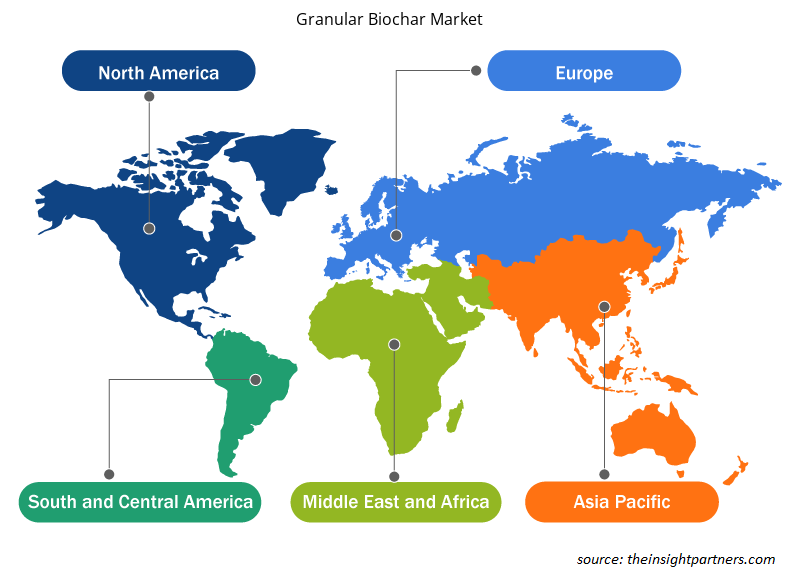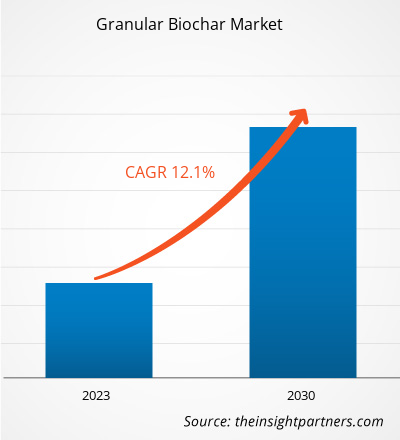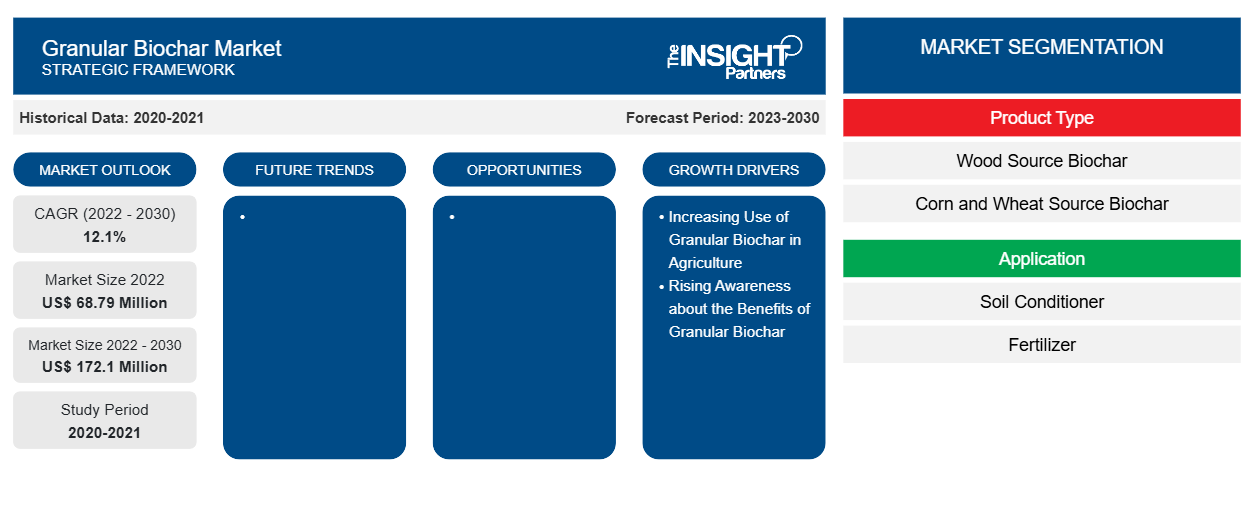[Rapport de recherche] La taille du marché du biochar granulaire devrait passer de 68 789,87 milliers de dollars américains en 2022 à 172 103,82 milliers de dollars américains d'ici 2030 ; elle devrait enregistrer un TCAC de 12,1 % de 2022 à 2030.biochar market size is expected to grow from US$ 68,789.87 thousand in 2022 to US$ 172,103.82 thousand by 2030; it is estimated to register a CAGR of 12.1% from 2022 to 2030.
ANALYSE DE MARCHÉ
Le marché mondial du biochar granulairebiochar market a connu une croissance notable ces dernières années, stimulée par une demande croissante de produits durables. Le biochar granulaire est fabriqué à partir de matières premières telles que les eaux usées, les déchets de jardin, les déchets alimentaires, les résidus de récolte et les essences de feuillus. Dans la production de biochar granulaire, les matières premières et les conditions de traitement jouent un rôle important dans le rendement et les propriétés du produit final. L'application de biochar au sol contribue à réduire la pollution hors site. Il augmente la rétention de nutriments tels que le phosphore et l'azote dans le sol. Cela diminue le lessivage des nutriments du sol dans les eaux souterraines et aide à préserver les nutriments de l'érosion due à l'écoulement des eaux de surface.biochar is manufactured using raw materials such as sewage, yard waste, food waste, crop residues, and hardwood species. In granular biochar production, feedstock and processing conditions play an important role in the yield and properties of the final product. The application of biochar to the soil helps in the reduction of offsite pollution. It increases the retention of nutrients such as phosphorous and nitrogen in the soil. This decreases the leaching of nutrients from the soil into the groundwater and helps save nutrients from erosion due to the surface water flow.
L'utilisation croissante du biochar granulaire dans l'agriculture en raison de ses avantages avancés a encore facilité l'expansion du marché du biochar granulaire. En utilisant divers taux d'application et techniques de préparation, le biochar granulaire est appliqué aux sols agricoles. Le taux d'application et de préparation du biochar granulaire dépend principalement des conditions spécifiques du sol et des matériaux utilisés pour fabriquer le biochar granulaire. Le biochar granulaire contribue à améliorer la fertilité du sol, ce qui stimule la croissance des plantes. En raison de la capacité du biochar granulaire à retenir les nutriments du sol pendant de longues périodes, il réduit le besoin d'engrais chimiques. En outre, les tendances mondiales du marché du biochar granulaire incluent l'utilisation du biochar granulaire dans le traitement de l'eau et des eaux usées
MOTEURS DE CROISSANCE ET DÉFIS
L'agriculture est l'un des principaux domaines d'application du biochar granulaire. L'industrie agricole prolifère et offre plusieurs opportunités de croissance pour le marché du biochar granulaire. Ces dernières années, l'intérêt pour l'utilisation du biochar dans l'agriculture a augmenté en raison des propriétés bénéfiques de ce matériau. L'application de biochar granulaire aux sols tempérés peut améliorer une variété d'indicateurs de santé du sol. La santé du sol est la capacité du sol à fonctionner comme un système vivant pour maintenir la productivité biologique et maintenir la qualité de l'environnement. Le biochar granulaire a le potentiel de retenir les nutriments du sol tels que l'ammonium, le nitrate et le phosphore, et cet effet est plus facilement observé dans les sols à texture légère. Le biochar granulaire contribue à améliorer l'état de fertilité du sol et à augmenter la productivité des cultures.
La dégradation des sols est une préoccupation majeure dans l'agriculture mondiale. Le biochar est appliqué aux sols dégradés pour améliorer leur qualité et résoudre ce problème croissant. Le biochar granulaire contribue à améliorer la qualité du sol en améliorant sa structure, en augmentant la rétention et l'agrégation de l'eau, en diminuant l'acidité, en améliorant la porosité, en régulant la lixiviation de l'azote et en améliorant les propriétés microbiennes. Il s'avère également bénéfique pour le compostage. Il aide à réduire les émissions de gaz à effet de serre et empêche la perte de nutriments dans le matériau de compost. Il aide également à réduire les pertes d'ammoniac, la densité apparente et l'odeur du compost. Ces avantages associés au biochar granulaire renforcent sa demande de la part de l'industrie agricole.Biochar is applied to degraded soils to enhance their quality and address this burgeoning problem. Granular biochar helps to improve soil quality by enhancing soil structure, increasing water retention and aggregation, decreasing acidity, improving porosity, regulating nitrogen leaching, and improving microbial properties. It is also found to be beneficial for composting. It helps reduce greenhouse gas emissions and prevents the loss of nutrients in the compost material. It also helps to reduce the compost's ammonia losses, bulk density, and odor. These associated benefits of granular biochar are bolstering its demand from the agriculture industry.
En Amérique du Nord, divers groupes régionaux soutiennent la production et l'utilisation du biochar dans l'industrie agricole. Par exemple, le Pacific Northwest Biochar Atlas est une ressource pour les utilisateurs et les producteurs de biochar. Le Pacific Northwest Biochar Atlas guide les agriculteurs, les jardiniers et les autres utilisateurs finaux sur les avantages potentiels du biochar, y compris les outils d'aide à la décision pour sélectionner le biochar et les taux d'amendement. La California Biochar Association cherche à créer une voix forte et cohérente à l'échelle de l'État pour défendre la production et l'utilisation du biochar dans l'agriculture et d'autres industries. En outre, la mission de la Sonoma Biochar Initiative est d'impliquer les parties prenantes dans les avantages du biochar en tant qu'outil de politique climatique et d'avantages agricoles. Ainsi, la demande croissante de biochar granulaire de la part de l'industrie agricole stimule la croissance du marché mondial du biochar granulaire.
Selon les Nations Unies, la population mondiale devrait augmenter d'environ 2 milliards de personnes au cours des 30 prochaines années ; elle devrait passer de 8 milliards en 2022 à 9,7 milliards en 2050. La population atteindrait un nouveau pic à environ 10,4 milliards au milieu des années 2080. Ces statistiques ont alarmé le secteur agricole quant à la demande alimentaire croissante qui en résulte. En conséquence, les agriculteurs du monde entier se concentrent sur la modification des pratiques agricoles pour obtenir des rendements élevés à partir de zones de culture plus petites. Par conséquent, le besoin d' engrais dans l'agriculture, y compris le biochar granulaire, augmente avec un accent majeur sur la protection des cultures et l'amélioration des rendements dans le secteur agricole. Ainsi, divers avantages du biochar granulaire pour la protection des cultures et l'amélioration des rendements contribuent à la taille du marché mondial du biochar granulaire. Le biochar granulaire contient des contaminants introduits par sa matière première ou coproduits lors de la pyrolyse. Le biochar granulaire fabriqué par pyrolyse à haute température dans des conditions d'oxygène limitées peut contenir des contaminants bien connus tels que les hydrocarbures aromatiques polycycliques (HAP), les éléments potentiellement toxiques (ETP), les dioxines, les composés organiques volatils (COV) et les contaminants émergents tels que les radicaux libres persistants et le cyanure métallique. Ainsi, les contaminants présents dans le biochar granulaire freinent la croissance du marché du biochar granulaire.
Personnalisez ce rapport en fonction de vos besoins
Vous bénéficierez d'une personnalisation gratuite de n'importe quel rapport, y compris de certaines parties de ce rapport, d'une analyse au niveau des pays, d'un pack de données Excel, ainsi que de superbes offres et réductions pour les start-ups et les universités.
-
Obtenez les principales tendances clés du marché de ce rapport.Cet échantillon GRATUIT comprendra une analyse de données, allant des tendances du marché aux estimations et prévisions.
SEGMENTATION ET PORTÉE DU RAPPORT
Le « Marché mondial du biochar granulaire jusqu’en 2030 » est une étude spécialisée et approfondie qui met l’accent sur les tendances et les opportunités du marché. Le rapport vise à fournir un aperçu du marché avec une segmentation détaillée du marché en fonction du type de produit, de l’application et de la géographie. Le marché mondial du biochar granulaire a connu une croissance significative au cours des dernières années et devrait poursuivre cette tendance au cours de la période de prévision. Le rapport fournit des statistiques clés sur l’utilisation du biochar granulaire dans le monde, ainsi que sur sa demande dans les principales régions et pays. Il fournit également une évaluation qualitative de divers facteurs affectant les performances du marché dans les principales régions et pays. Le rapport comprend également une analyse complète des principaux acteurs du marché et de leurs principaux développements stratégiques. Plusieurs analyses sur la dynamique du marché sont également incluses pour aider à identifier les principaux facteurs moteurs, les tendances du marché et les opportunités lucratives qui, à leur tour, aideraient à identifier les poches de revenus importantes.
L'analyse de l'écosystème et l'analyse des cinq forces de Porter fournissent également une vue à 360 degrés de l'analyse du marché mondial du biochar granulaire, ce qui permet de comprendre l'ensemble de la chaîne d'approvisionnement et divers facteurs affectant la croissance du marché.
ANALYSE SEGMENTALE
Le marché mondial du biochar granulaire est segmenté en fonction du type de produit et de l'application. En termes de type de produit, le marché est segmenté en biochar d'origine bois, biochar d'origine maïs et blé, et autres. Par application, le marché est segmenté en amendements de sol , engrais et autres.
Français Sur la base du type de produit, le segment du biochar à base de maïs et de blé détenait une part de marché mondiale importante du biochar granulaire en 2022. Le biochar à base de maïs et de blé est dérivé de la paille de maïs, et le biochar à base de maïs est mélangé à tous les sols alcalins à des niveaux de charge de 0 %, 2,5 %, 5 % et 10 % et exposé aux éléments naturels. Le biochar est produit à partir de sources de maïs par pyrolyse lente de la paille de maïs à 450 degrés avec un temps de séjour de 2 heures dans des conditions d'oxygène limitées. Sur la base de l'application, le segment des engrais a dominé le marché avec une part de marché importante en 2022. Le biochar granulaire, avec sa structure poreuse et sa teneur élevée en carbone, a gagné en importance en tant qu'amendement polyvalent du sol, offrant une gamme d'avantages pour la croissance des plantes et la rétention des nutriments. En tant qu'alternative aux engrais, le biochar granulaire améliore la fertilité du sol en augmentant la disponibilité et l'absorption des nutriments pour les plantes.
ANALYSE RÉGIONALE
Le rapport sur le marché du biochar granulaire fournit un aperçu régional détaillé du marché. L'APAC représentait une part importante du marché mondial du biochar granulaire et était évaluée à environ 55 millions de dollars américains en 2022. La Chine est un contributeur majeur à la croissance du marché dans cette région. L'Amérique du Nord devrait également connaître une croissance notable, atteignant plus de 25 millions de dollars américains d'ici 2030. De plus, en Europe, l'utilisation du biochar granulaire est généralisée. Le marché du biochar granulaire en Europe devrait afficher un TCAC d'environ 12 % de 2022 à 2030.
Aperçu régional du marché du biochar granulaire
Les tendances et facteurs régionaux influençant le marché du biochar granulaire tout au long de la période de prévision ont été expliqués en détail par les analystes d’Insight Partners. Cette section traite également des segments et de la géographie du marché du biochar granulaire en Amérique du Nord, en Europe, en Asie-Pacifique, au Moyen-Orient et en Afrique, ainsi qu’en Amérique du Sud et en Amérique centrale.

- Obtenez les données régionales spécifiques au marché du biochar granulaire
Portée du rapport sur le marché du biochar granulaire
| Attribut de rapport | Détails |
|---|---|
| Taille du marché en 2022 | 68,79 millions de dollars américains |
| Taille du marché d'ici 2030 | 172,1 millions de dollars américains |
| Taux de croissance annuel moyen mondial (2022-2030) | 12,1% |
| Données historiques | 2020-2021 |
| Période de prévision | 2023-2030 |
| Segments couverts |
Par type de produit
|
| Régions et pays couverts |
Amérique du Nord
|
| Leaders du marché et profils d'entreprises clés |
|
Densité des acteurs du marché du biochar granulaire : comprendre son impact sur la dynamique commerciale
Le marché du biochar granulaire connaît une croissance rapide, tirée par la demande croissante des utilisateurs finaux en raison de facteurs tels que l'évolution des préférences des consommateurs, les avancées technologiques et une plus grande sensibilisation aux avantages du produit. À mesure que la demande augmente, les entreprises élargissent leurs offres, innovent pour répondre aux besoins des consommateurs et capitalisent sur les tendances émergentes, ce qui alimente davantage la croissance du marché.
La densité des acteurs du marché fait référence à la répartition des entreprises ou des sociétés opérant sur un marché ou un secteur particulier. Elle indique le nombre de concurrents (acteurs du marché) présents sur un marché donné par rapport à sa taille ou à sa valeur marchande totale.
Les principales entreprises opérant sur le marché du biochar granulaire sont :
- Carbone cyclique Pty Ltd
- Technologie internationale avancée des énergies renouvelables Inc.
- CharGrow USA LLC
- Airex Énergie Inc.
- Carbonis GmbH & Co KG
Avis de non-responsabilité : les sociétés répertoriées ci-dessus ne sont pas classées dans un ordre particulier.

- Obtenez un aperçu des principaux acteurs clés du marché du biochar granulaire
DÉVELOPPEMENTS DE L'INDUSTRIE ET OPPORTUNITÉS FUTURES
Les partenariats, les acquisitions et les lancements de nouveaux produits sont quelques-unes des stratégies importantes adoptées par les acteurs opérant sur le marché mondial du biochar granulaire.
- En janvier 2024, Pyreg GmbH a annoncé la fourniture d'une usine de carbonisation à Black Bull Biochar pour un site industriel dans le nord de l'Angleterre. Le marché britannique du biochar est fragmenté et naissant. La collaboration avec Black Bull Biochar a élargi les possibilités pour Pyreg GmbH de s'implanter sur un nouveau marché.
- En avril 2022, Pyreg GmbH a annoncé la création d'une filiale aux États-Unis. La filiale nouvellement créée est située à Portland, dans le Maine. La décision d'expansion est une réponse à la demande croissante pour sa technologie CDR aux États-Unis. Au cours de l'exercice 2023, l'entreprise avait pour objectif de lancer l'exploitation de deux centrales à biomasse dans le but de générer une élimination de carbone de 3 000 tonnes de CO2 de l'atmosphère.
PAYSAGE CONCURRENTIEL ET ENTREPRISES CLÉS
Cyclic Carbon Pty Ltd, Advanced Renewable Technology International Inc, CharGrow USA LLC, Airex Energy Inc, Carbonis GmbH & Co KG, Pyreg GmbH, Oregon Biochar Solutions, Arsta Eco Pvt Ltd, American BioChar Co et BioChar6 sont quelques-uns des principaux acteurs analysés dans le rapport sur le marché mondial du biochar granulaire.
- Analyse historique (2 ans), année de base, prévision (7 ans) avec TCAC
- Analyse PEST et SWOT
- Taille du marché Valeur / Volume - Mondial, Régional, Pays
- Industrie et paysage concurrentiel
- Ensemble de données Excel
Rapports récents
Rapports connexes
Témoignages
Raison d'acheter
- Prise de décision éclairée
- Compréhension de la dynamique du marché
- Analyse concurrentielle
- Connaissances clients
- Prévisions de marché
- Atténuation des risques
- Planification stratégique
- Justification des investissements
- Identification des marchés émergents
- Amélioration des stratégies marketing
- Amélioration de l'efficacité opérationnelle
- Alignement sur les tendances réglementaires























 Obtenez un échantillon gratuit pour - Marché du biochar granulaire
Obtenez un échantillon gratuit pour - Marché du biochar granulaire